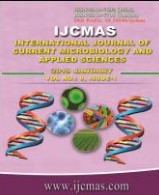


 National Academy of Agricultural Sciences (NAAS)
National Academy of Agricultural Sciences (NAAS)

|
PRINT ISSN : 2319-7692
Online ISSN : 2319-7706 Issues : 12 per year Publisher : Excellent Publishers Email : editorijcmas@gmail.com / submit@ijcmas.com Editor-in-chief: Dr.M.Prakash Index Copernicus ICV 2018: 95.39 NAAS RATING 2020: 5.38 |
Nutrient management has played a main role in achieving self-sufficiency in food grain production. A field experiment was conducted during Rabi 2016-17 and 2017-18 to evaluate nutrient requirement of wheat using Nutrient Expert Model (NE is a simple computer based decision support system or delivery tool developed by IPNI [International Plant Nutrition Institute] that can rapidly provide nutrient recommendations for N, P and K for crops). The experiment was conducted in Randomized Block Design replicated thrice at Wheat and Barley Research area, CCS HAU, Hisar, Haryana. Seven treatments executed were absolute control (without NPK), Recommended dose of fertilizer (RDF; 150 kg N/ha, 60 kg P2O5/ha and 40 kg K2O/ha), 150% RDF, 150% PK, 150% NK, 150% NP and compared with NE (Nutrient Expert Recommendation).Based on pooled two years data 2016-17 and 2017-18, experiment revealed that the highest grain yield (61.27 q/ha) was recorded when 150% recommended dose of fertiliser was applied which was significantly higher than other treatments except when fertiliser was applied on the basis of nutrient expert model (58.80 q/ha). Similarly, the maximum biological yield (146.22 q/ha) was obtained from 150% RDF followed by NE (145.67 q/ha). Minimum grain and biological yield was recorded from absolute control treatment which was without fertilizer application. Maximum number of effective tillers/m2 (428) and plant height (101.4 cm) were also recorded when 150% recommended dose of fertiliser was applied. Boldest grain was produced by control (no fertilizer; 41.06 g) treatment. Maximum number of grains per ear head (38.89) was recorded from 150% NK treatment. Lowest grain yield (41.06 q/ha) was recorded from control (no fertilizer) followed by application of 150% recommended dose of phosphorus and potash without nitrogen. Nutrient Expert based practices produced higher productivity in comparison to recommended dose of fertilizer. Nutrient expert significantly reduced N fertilizer input while maintain higher yield when compared with 150% RDF. The application of fertilizers on the basis of recommendation of decision support system “Nutrient expert” proved satisfactory.
 |
 |
 |
 |
 |